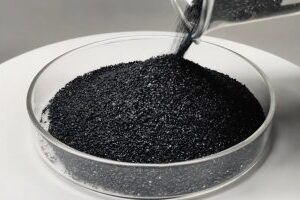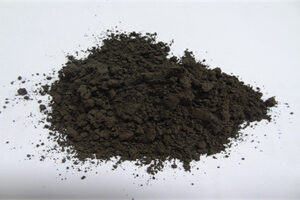Application of chromite powder in the research and development of color glaze pigments

The application of chromite powder in the research and development of color glaze pigments is mainly reflected in the following aspects:
1. Basic coloring function
Multi-color presentation
Chromite powder can present green, purple, blue, yellow and other colors in glazes through the change of the oxidation state of chromium. For example, chromium oxide (Cr₂O₃) reacts with the glaze matrix during high-temperature firing to produce a stable green or blue-green hue.
Enhanced metallic luster
Chromium elements can form metal oxide crystal structures in glazes, giving the ceramic surface a unique metallic luster and enhancing the visual effect of artistic ceramics.
2. Color regulation and blending technology
Chemical valence regulation
By controlling the firing atmosphere (oxidation or reduction), adjusting the valence of chromium elements (such as Cr³⁺ or Cr⁶⁺), a gradual change effect from dark green to orange-yellow can be achieved. Compound ratio color matching
Chromite powder can be used in combination with other colorants (such as iron oxide, cobalt, manganese, etc.) to expand the color gamut.
For example:
Combined with cobalt oxide to produce a blue-purple tone;
Mixed with iron oxide to produce a brown-green composite effect.
3. Performance and process adaptability
High temperature stability
Chromite powder can still maintain color stability at high temperatures of 1200-1400℃, avoiding fading or color difference during firing.
Sintering temperature optimization
Adding chromite powder can reduce the sintering temperature of alumina-based glazes (for example, from 1700℃ to about 1520℃), shorten the production cycle and reduce energy consumption.
4. Application scenario expansion
Art ceramics
Through refined blending, special effects such as antique glazes and crystal glazes can be produced to meet the color requirements of high-end artworks.
Industrial color standard products
Using the color repeatability of chromite powder, standardized industrial colorants are developed for mass production in the fields of electronic ceramics, building tiles, etc. Note: The addition ratio of chromite powder needs to be dynamically adjusted according to glaze composition (such as silicon-aluminum ratio), firing temperature and other parameters. Excessive addition may cause glaze cracking or excessive color.
Zhengzhou haixu abrasives co.,ltd,produce chromite powder for long time and can produce the following sizes:
180mesh(85um) ,200mesh(75um),270mesh(53um),325mesh(45um),400mesh(38um),500mesh(25um),600mesh(23mesh),800mesh(18um),1000mesh(13um),1200mesh(12um),1500mesh(10um),1600mesh(9um), 1800mesh(8um),2000mesh(6.5um),2200mesh(6um),2500mesh(3-5um)
If you need smaple to test or study,we can arrange it for you.






